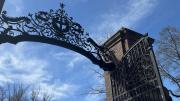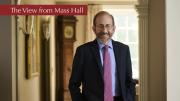Four days before last Christmas, the $300-billion California Public Employees’ Retirement System (CalPERS), the nation’s largest pension plan, announced that it would reduce the expected rate of return on its investments from 7.5 percent to 7 percent. That change might seem modest, and its context—an underfunded public-pension plan, like those run by many states, cities, and teacher or uniformed-services retirement funds—might seem remote from Harvard’s concerns.
But the direction of the change and its implications serve as a useful, cautionary analogy. CalPERS adjusted its rate-of-return assumption after failing to earn it for an extended period. Resetting the rate means that it expects a higher share of costs to be paid by its member government agencies, as the contribution from investment returns is diminished. In addition, CalPERS blandly noted, employers will see increases in their “unfunded actuarial liabilities.” The figures are not small: the state expects its direct pension costs to rise 40 percent, or $2 billion, annually, and plan sponsors generally can expect their costs to rise 1 percent to 5 percent of payroll. Unfunded accrued liability payments, to be made over 20 years to fill the existing gap, will rise 30 percent to 40 percent. In other words, spending on public safety, education, and parks must be reduced—or towns and school districts must find more revenue to maintain such services while they cover the higher pension costs.
Harvard does not face budget-busting pension and retiree healthcare obligations. But its ability to realize its academic aspirations depends directly on the performance of its investments. Distributions from the endowment made up 36 percent of operating revenues in fiscal year 2016—just two percentage points less than all student tuition and fee payments and sponsored-research funds combined. Budgets are built assuming that endowment returns reach Harvard’s 8 percent target: sufficient to distribute 5 percent of the value each year, and preserve future purchasing power as higher-education costs inflate. But actual returns have averaged 5.7 percent during the past decade (see, respectively, harvardmag.com/distribution-16 and harvardmag.com/endowment-drop-16). The sweeping changes at Harvard Management Company announced this past January by its new president, N.P. Narvekar, are intended, urgently, to enhance returns (see harvardmag.com/hmc-overhaul-17).
In the meantime, in the midst of the largest capital campaign in higher-education history, with well more than $7 billion given or pledged, that gap in endowment returns shows up across the University. The medical and engineering schools, busily investing in promising research, continue to show operating losses; the Faculty of Arts and Sciences, having drawn down endowment and unrestricted funds to pay for House renewal (and still straining to finance that huge project), expects to fall back into the red next year, a victim of endowment-driven budget constraints. Having effectively frozen the number of professors for several years, it will continue to do so—and disclosed in February that graduate admissions will be cut by more than 4 percent (see “Graduate Admissions in Lower Gear”).
Given modest expectations for tuition income and federal support for research, Harvard’s pursuit of its academic mission depends very much on the success of Narvekar and his colleagues—a multiyear project; continued philanthropic largess; and a tighter rein on spending than has been the norm. But today’s changing investment opportunities threaten the University’s basic financial assumptions. As the CalPERS CEO explained, “We lowered the rate because experts…advised us that…the long-term financial outlook had darkened. Achieving a 7.5 percent return…was now far less likely than it was just two years ago when we last revisited it.” Ominously, the agency had previously lowered its discount rate, from 7.75 percent to 7.5 percent, in 2012.
If internal improvements and external conditions do not yield Harvard’s hoped-for investment returns, other things will have to give: the scope of academic ambitions, employees’ income and benefits, and so on. The investment arithmetic suggests that Harvard could face the equivalent of the painful trade-offs now facing California. john s. rosenberg, Editor








